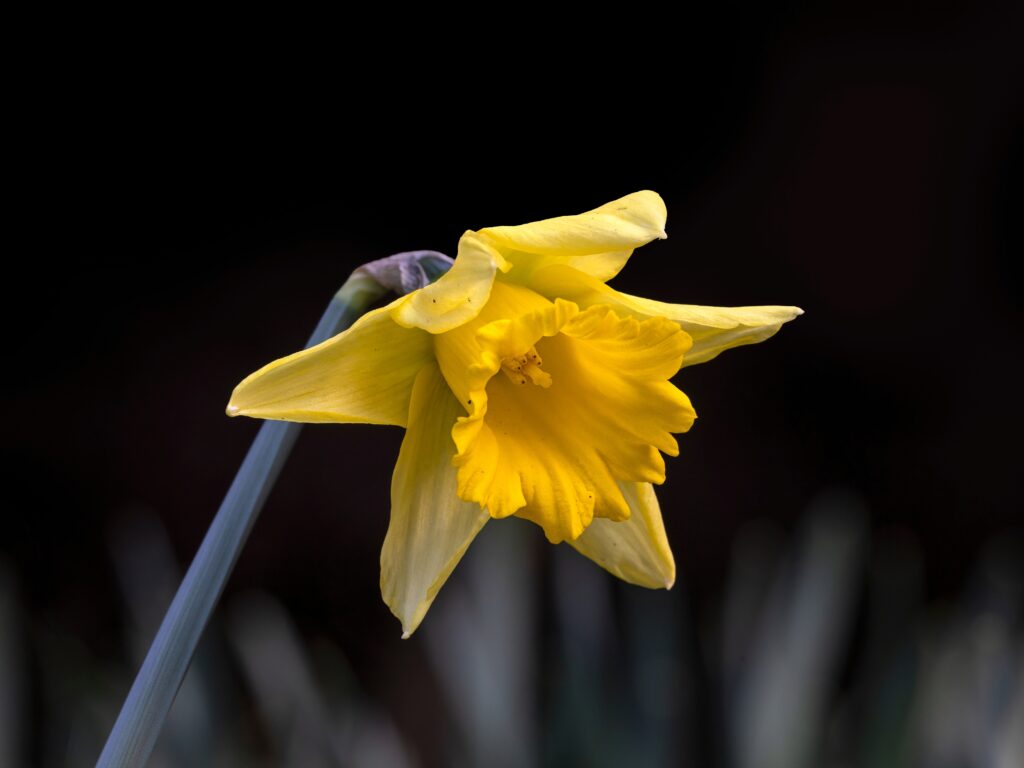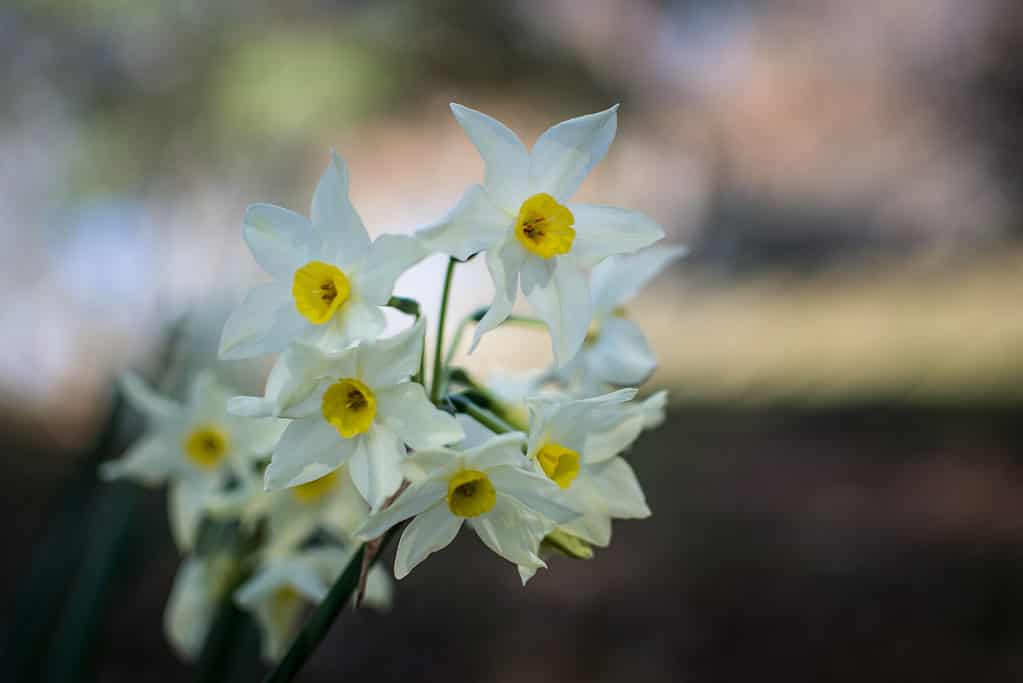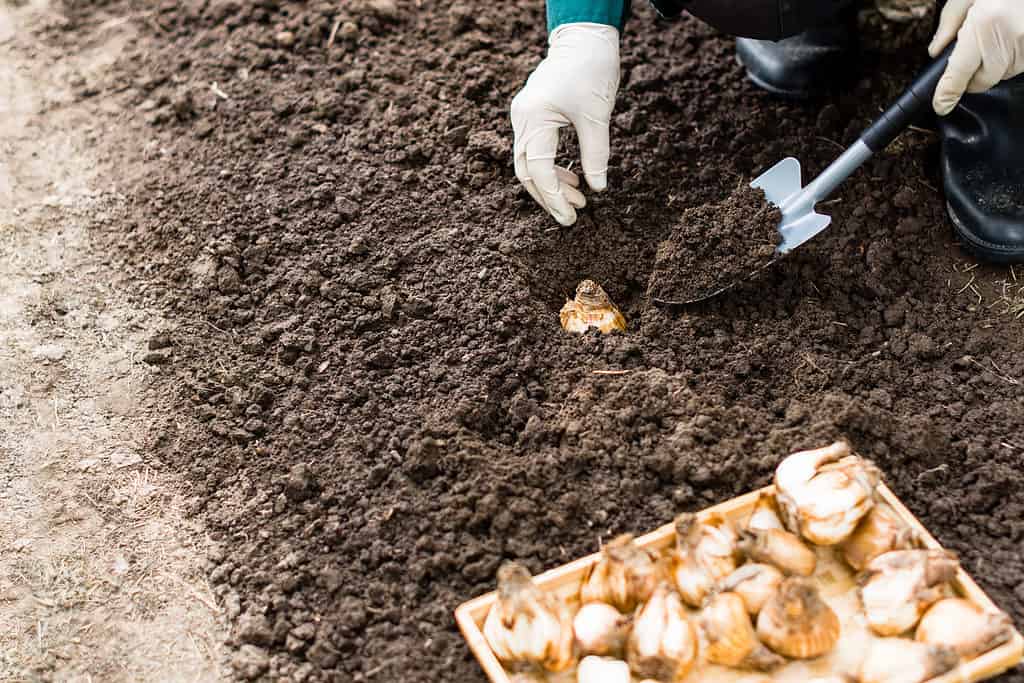In the US, most daffodil bulbs become blooming plants in the spring. But they must first lie dormant through many weeks of cold weather. For that reason, daffodil bulbs are usually planted in the fall. However, that timing depends on your growing Zone – and your hemisphere if you live elsewhere. Also, the best time to plant different daffodil varieties could vary slightly based on the daffodil type.
So, let’s walk through some easy steps for deciding when to plant daffodil bulbs in your garden. We’ll also discuss planting tips and how daffodils are divided into divisions to identify them.

In the US, most daffodil bulbs are planted in the fall and bloom in the spring.
©Chris Lawrence Travel/Shutterstock.com
Why plant daffodils in the fall?
There are two main reasons that daffodil bulbs are best planted in the fall in the United States.
- Daffodil bulbs need a period of cold weather dormancy underground for weeks to produce flowers in the spring. According to an article from Purdue University, the average cold weather dormancy for daffodils ranges from 10-13 weeks at temps below 40 degrees Fahrenheit.
- Flower bulbs also need this time underground to grow strong roots for spring-blooming plants.
So, the best time to plant daffodil bulbs is when air and soil temps in your area drop below 40 degrees.
However, that means differing climates require different planting times. Keep reading to learn more about planting daffodils in warm climates vs. colder ones.

Jonquilla or jonquil daffodils love the warmer climate of the southern United States.
©iStock.com/Steven Giles
When to Plant Daffodil Bulbs: Warm vs. Cold Climates
When deciding when to plant daffodil bulbs in your area, consider the climate where you live. The best time to plant your daffodils depends on your cold weather averages and your hemisphere.
Planting Daffodils by USDA Hardiness Zones
The United States Department of Agriculture (USDA) manages a map of Hardiness Zones for the entire country. According to the USDA, the map identifies the average lowest winter temperatures per area per year. As a result, US residents learn their coldest weather averages from this map for garden planning.
A plant’s hardiness means its ability to survive challenging weather, like extreme cold or heat, in each Zone. For example, a hardy daffodil plant in Zone 5 usually survives temperatures above 10-20 degrees Fahrenheit. But it likely won’t survive temps dipping lower than that.
In colder US climates, like Zones 3-8, daffodil bulbs should go in the ground in early fall and before the first frost. This timing is so daffodil bulbs get plenty of weeks in cold dormancy for strong root growth during this climate’s harsher winter.
In warmer climates, such as Zones 8-10, you could plant daffodil bulbs starting in November. That timing works in this climate because the soil is still warm enough for roots to grow. However, note that growing daffodils in Zones 11 and higher could be difficult or impossible due to lack of a long enough cold dormancy period. Yet a way around that is to force daffodil bulbs to bloom indoors during any season of the year.
Planting Daffodils by Hemisphere
There’s a big difference between planting daffodil bulbs in the southern and northern hemispheres because the average temperatures in each season are the opposites of each other. In other words, fall weather in the southern hemisphere is too warm for daffodil bulb planting. So, in the southern hemisphere, you would plant your bulbs in spring.
For example, you plant daffodils in the fall in Canada (the northern hemisphere) but would plant them in the spring in New Zealand (the southern hemisphere). And you’d probably plant your daffodils in April if you live in South Africa (the southern hemisphere). But if you live in Japan (the northern hemisphere), you’d plant daffodil bulbs in September or October.
Regardless of where you live, pay attention to the bulb supplier’s planting instructions for their suggestions.

The ‘February Gold’ daffodil blooms in late winter or early spring.
©Peter Etchells/Shutterstock.com
When to Plant Different Types of Daffodils
In general, if you’re in the US or the northern hemisphere, plant daffodil bulbs anytime in the fall. However, knowing the growth habits of different types of daffodils could also help you prioritize which bulbs to plant.
For example, the ‘February Gold’ cultivar is a miniature cyclamineous daffodil that blooms in late winter or early spring. So, ‘February Gold’ could be some of the first bulbs you plant in early fall.
Planning a garden with a mix of early, mid, and late spring blooming plants ensures you have lovely flowers all season!
To learn more about when specific cultivars produce flowers, read the growing instructions from your plant suppliers. And read our many articles about excellent types of daffodil cultivars for home gardens!

Poeticus daffodils typically bloom in late spring.
©Rabbitti/Shutterstock.com
Planting Daffodil Bulbs by Division
Each daffodil cultivar also belongs to a specific daffodil division for classification. These divisions help gardeners learn how each type of daffodil will look and grow. Though each daffodil division identifies specific growth habits, here we’ll focus on their average bloom timing for garden planning.
The list of 13 daffodil divisions below might help you decide which bulbs to plant first (in the fall) based on which ones bloom earliest in spring. Though as long as all of the bulbs get a full dormancy period in cold weather, it doesn’t matter which bulbs you plant first. Just get them all in the ground during the autumn months and watch for lovely flowers in the spring!
The Daffodil Divisions
- Trumpet Daffodils (Division #1) – Most trumpet daffodils produce flowers in the early to mid-spring.
- Large-Cupped Daffodils (Division #2) – Large-cupped daffodils usually bloom in mid-spring.
- Small-Cupped Daffodils (Division #3) – A large percentage of small-cupped daffodils produce flowers in the mid to late spring.
- Double Daffodils (Division #4) – Double daffodils usually bloom in mid to late spring.
- Triandrus Daffodils (Division #5) – You can expect triandrus daffodils to flower in mid to late spring.
- Cyclamineous Daffodils (Division #6) – Most cyclamineous daffodils bloom in early to mid-spring.
- Jonquilla Daffodils (Division #7) – The jonquilla or jonquil daffodil often blooms in mid to late spring.
- Tazetta Daffodils (Division #8) – Many tazetta daffodils produce flowers in mid to late spring.
- Poeticus Daffodils (Division #9) – The poeticus daffodil typically produces flowers in late spring.
- Bulbocodium Daffodils (Division #10) – The bloom timing of bulbocodium daffodils varies by cultivar. However, they tend to bloom for many weeks through spring and have long-lasting flowers.
- Split-Cupped Collar Daffodils (Division #11a) – Many split-cupped collar daffodils bloom in early to mid-spring.
- Split-Cupped Papillion Daffodils (Division #11b) – The split-cupped papillion daffodil usually produces flowers in mid-spring.
- Other Daffodil Cultivars (Division #12) – The flower timing of daffodils in this division varies from plant to plant.
- Daffodils Distinguished by their Botanical Name (Division #13) – This division is another one where the timing of blooms varies between plant types.
Keep in mind that the timing of daffodil blooms also depends on the climate, cultivar, and other factors. But knowing the general timing of when to expect flowers helps daffodil growers prioritize some bulb plantings over others.

Plant daffodil bulbs about 6 inches below the soil surface with their pointed tip facing up.
©Jurga Jot/Shutterstock.com
Planting Daffodil Bulbs: Basic Tips
Planting daffodil bulbs is easy, but here are some tips for getting your bulbs off to a strong start.
- Wear gloves and long sleeves when handling daffodil bulbs and plants. Because they contain an alkaloid compound called lycorine, all parts of daffodils are toxic. So, cover bare skin when touching daffodil bulbs or plants. And don’t let pets or children put them in their mouths. Eating daffodil bulbs or plants could cause severe digestive upset, like nausea, vomiting, and stomach cramps.
- Daffodils need plenty of sunlight (6-8 hours a day), so plant them in a sunny area. However, that doesn’t mean you can’t plant daffodil bulbs near deciduous trees that hang overhead. Especially if your daffodil cultivars bloom early in spring, leafy branches above won’t typically be an issue. Most deciduous tree limbs will still be bare enough in spring to allow lots of light to filter through them to the daffodils below.
- Give your daffodil bulbs high-quality and well-draining soil.
- Plant daffodil bulbs about 6 inches under the soil surface and with the pointed end facing up. And space the bulbs about 3-4 inches (or more) apart.
- When you plant the bulbs, apply a balanced fertilizer or organic compost to the soil. Then top the ground with mulch and give the planted bulbs plenty of water. Also, water them each week for a few weeks to help the roots grow and anchor the bulbs in the ground before winter.
- Once established (after a few weeks), stop watering the bulbs and let them lie dormant underground through winter. You will start watering them again when they produce plants in the spring.

Daffodil bulbs produce more beautiful blooms if you divide their clumps every five or so years and replant them.
©Sergey V Kalyakin/Shutterstock.com
How to Take Care of Daffodils Plants
In addition to being simple to grow, daffodil plants are easy to maintain. Check out our list below of quick tips on caring for daffodil plants once they appear in spring.
- Unless you’re in a location that receives consistent spring rain, you’ll want to water your daffodil plants weekly after the plants emerge above ground.
- Deadhead (remove) spent blooms, but only prune daffodil plants once they die back fully and naturally. This practice allows the bulbs to store enough energy from their plants to produce flowers again next year.
- Stop watering your daffodils when the plants begin turning yellow and dying back.
- Once daffodil plants have turned brown and died, prune the plants down to ground level.
- It’s typically unnecessary, but you could fertilize your daffodils again in the spring. However, if you fertilize daffodils in the spring, it’s best to do it early. So watch for a few inches of plant growth, then apply your fertilizer to the soil.
Dig up your growing clumps of daffodil bulbs in about five years to separate and replant them. If you don’t eventually divide them, your overcrowded bulbs could produce fewer flowers.

Fall daffodil bulb plantings bring spring blooms for most US gardeners.
©Andreas Krumwiede/Shutterstock.com
Fall daffodil bulbs bring spring daffodil flowers.
For US gardeners, the quickest way to remember when to plant daffodil bulbs is to think of this simple phrase – fall bulbs bring spring flowers. Of course, there are exceptions to this rule, especially if you live in a warm climate or the southern hemisphere. However, for most US gardeners, planting daffodil bulbs between September and November should produce flowering daffodils in the spring.
Knowing your daffodil cultivar, division, and local climate is essential for the best daffodil plant performance. We hope all your daffodil bulb plantings bring you loads of lovely blooms!
The photo featured at the top of this post is © Sergey V Kalyakin/Shutterstock.com
Thank you for reading! Have some feedback for us? Contact the AZ Animals editorial team.






